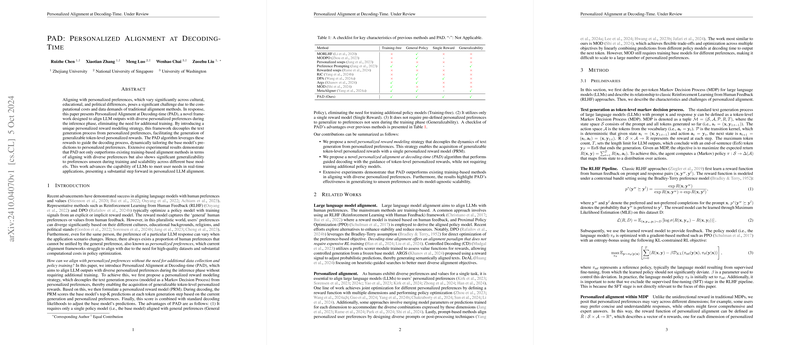Personalized Alignment at Decoding-Time (PAD): An Overview
The paper "PAD: Personalized Alignment at Decoding-Time" introduces a novel framework aimed at aligning the outputs of LLMs with personalized preferences during decoding. The proposed method, Personalized Alignment at Decoding-time (PAD), addresses the challenge of conforming to diverse user preferences without additional data collection or training. This approach effectively decouples the dynamics of the text generation process from the alignment with personalized preferences through a unique personalized reward modeling strategy.
Key Contributions
The paper makes several noteworthy contributions to the field of personalized alignment in LLMs:
- Decoupling Alignment and Text Generation: The authors propose a framework where the text generation is treated as a Markov Decision Process (MDP). They introduce a personalized reward modeling strategy that enables the acquisition of token-level personalized rewards, which are generalizable and independent of MDP dynamics. This innovative approach eliminates the need for retraining models to accommodate new preferences.
- Guided Decoding with Personalized Rewards: The PAD framework employs a novel decoding algorithm that uses token-level personalized rewards to guide the generation process. This enables the model's predictions to dynamically adapt based on personalized preferences, leveraging a single reward model without additional policy training.
- Experimental Validation: Through extensive experimentation, the paper demonstrates that PAD significantly outperforms existing training-based alignment methods in aligning with diverse preferences. Moreover, PAD exhibits strong generalizability to unseen preferences and scalability across different base models.
Experimental Insights
The paper showcases that PAD can align LLM outputs with multiple preferences simultaneously, outperforming several baselines such as MORLHF, MODPO, and MetaAligner in achieving superior alignment across different dimensions like "helpfulness," "harmlessness," and "humor." This is evidenced through both reward model scoring and GPT-4 evaluations. Notably, PAD consistently enhances alignment capabilities on pre-defined and customized preferences, maintaining performance even when applied to various LLM architectures.
Implications and Future Directions
The implications of PAD are substantial in the context of real-time applications of LLMs. By enabling personalized alignment during decoding, PAD opens up new possibilities for deploying LLMs in settings where user preferences are diverse and dynamically changing, without the prohibitive costs associated with traditional retraining methods.
Theoretically, PAD aligns with the broader agenda of enhancing AI alignment to account for human value pluralism, contributing to the discourse on designing fair and adaptable AI systems. Practically, the framework's ability to generalize to unseen preferences hints at potential applications in personalized AI services, where adaptability to user-specific needs is paramount.
Future research could explore integrating PAD with more complex multi-modal LLMs, as well as further refining reward modeling to encompass even broader dimensions of personalization. Additionally, there is scope for optimizing decoding strategies to enhance efficiency and reduce computational overhead.
In summary, PAD stands as a significant advancement in the domain of LLM personalization, demonstrating efficacy in aligning with diverse user preferences at decoding time, thus setting a foundation for more adaptable and user-centric AI technologies.
